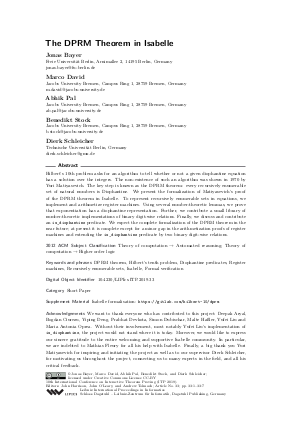@InProceedings{bayer_et_al:LIPIcs.ITP.2019.33,
author = {Bayer, Jonas and David, Marco and Pal, Abhik and Stock, Benedikt and Schleicher, Dierk},
title = {{The DPRM Theorem in Isabelle}},
booktitle = {10th International Conference on Interactive Theorem Proving (ITP 2019)},
pages = {33:1--33:7},
series = {Leibniz International Proceedings in Informatics (LIPIcs)},
ISBN = {978-3-95977-122-1},
ISSN = {1868-8969},
year = {2019},
volume = {141},
editor = {Harrison, John and O'Leary, John and Tolmach, Andrew},
publisher = {Schloss Dagstuhl -- Leibniz-Zentrum f{\"u}r Informatik},
address = {Dagstuhl, Germany},
URL = {https://drops.dagstuhl.de/entities/document/10.4230/LIPIcs.ITP.2019.33},
URN = {urn:nbn:de:0030-drops-110883},
doi = {10.4230/LIPIcs.ITP.2019.33},
annote = {Keywords: DPRM theorem, Hilbert’s tenth problem, Diophantine predicates, Register machines, Recursively enumerable sets, Isabelle, Formal verification}
}

 Creative Commons Attribution 3.0 Unported license
Creative Commons Attribution 3.0 Unported license



